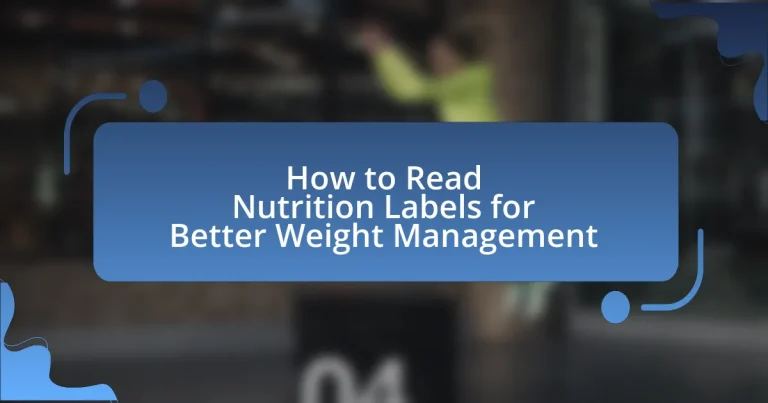Nutrition labels are essential tools found on food packaging that provide critical information about a product’s nutritional content, including calories, macronutrients, vitamins, and minerals. Understanding these labels is crucial for effective weight management, as they enable consumers to make informed dietary choices, control portion sizes, and monitor caloric intake. The article outlines how to read nutrition labels effectively, highlighting key components such as serving sizes, calorie counts, and nutrient breakdowns, while also addressing common pitfalls and strategies for better decision-making. By utilizing this information, individuals can enhance their meal planning and ultimately support healthier eating habits.

What are Nutrition Labels and Why are They Important for Weight Management?
Nutrition labels are detailed information panels found on food packaging that provide essential data about the nutritional content of the product, including calories, macronutrients, vitamins, and minerals. They are important for weight management because they enable consumers to make informed dietary choices by understanding the caloric and nutritional value of foods, which can help in controlling portion sizes and overall caloric intake. Studies have shown that individuals who regularly read nutrition labels are more likely to maintain a healthy weight and make healthier food choices, as they can identify high-calorie or nutrient-poor options and adjust their diets accordingly.
How do Nutrition Labels Help in Making Healthier Food Choices?
Nutrition labels help in making healthier food choices by providing essential information about the nutritional content of food products. These labels typically include details such as calorie count, macronutrient breakdown (fats, carbohydrates, and proteins), and micronutrient information (vitamins and minerals). By comparing these values, consumers can make informed decisions that align with their dietary needs and health goals. For instance, a study published in the Journal of Nutrition found that individuals who regularly read nutrition labels are more likely to choose lower-calorie and lower-fat options, leading to better weight management outcomes.
What key information can be found on a Nutrition Label?
A Nutrition Label provides essential information about the nutritional content of a food product. Key information includes serving size, calories per serving, total fat, saturated fat, trans fat, cholesterol, sodium, total carbohydrates, dietary fiber, total sugars, added sugars, protein, and various vitamins and minerals. This information helps consumers make informed dietary choices, as it allows them to assess the nutritional value and health implications of the food they consume. For instance, the serving size indicates how much of the product is considered one serving, which is crucial for understanding calorie and nutrient intake.
How can understanding Nutrition Labels influence portion control?
Understanding nutrition labels can significantly influence portion control by providing clear information on serving sizes, calorie content, and nutrient composition. When individuals read nutrition labels, they can identify the recommended serving size, which helps them gauge how much they should consume to avoid overeating. For instance, a study published in the Journal of the Academy of Nutrition and Dietetics found that consumers who understood serving sizes were more likely to manage their portion sizes effectively, leading to reduced caloric intake. This understanding enables individuals to make informed choices, ultimately supporting better weight management and healthier eating habits.
What are the Common Components of Nutrition Labels?
Common components of nutrition labels include serving size, calories, total fat, saturated fat, trans fat, cholesterol, sodium, total carbohydrates, dietary fiber, total sugars, added sugars, protein, and vitamins and minerals. Each component provides essential information for consumers to understand the nutritional value of the food product. For instance, the serving size indicates the amount typically consumed, while calories measure the energy provided. The presence of fats, sugars, and sodium helps consumers make informed choices regarding their dietary intake, which is crucial for weight management. The U.S. Food and Drug Administration mandates these components to ensure transparency and assist individuals in making healthier food choices.
What does the serving size indicate on a Nutrition Label?
The serving size on a Nutrition Label indicates the recommended amount of food or drink that is typically consumed in one sitting. This measurement serves as a standard reference for the nutritional information provided, allowing consumers to understand the amount of calories, fats, sugars, and other nutrients they will intake based on that specific portion. For example, if a serving size is listed as one cup, all nutritional values on the label correspond to that one-cup measurement, helping individuals manage their dietary intake effectively.
How are calories calculated and what do they mean for weight management?
Calories are calculated based on the energy content of food, which is determined by measuring the macronutrients: carbohydrates, proteins, and fats. Each macronutrient provides a specific amount of energy: carbohydrates and proteins provide 4 calories per gram, while fats provide 9 calories per gram. This calculation helps individuals understand the energy they consume, which is crucial for weight management.
For weight management, understanding calorie intake versus expenditure is essential. Consuming more calories than the body burns leads to weight gain, while burning more calories than consumed results in weight loss. Research indicates that a caloric deficit of approximately 500 to 1,000 calories per day can lead to a safe weight loss of about 1 to 2 pounds per week, as supported by the Centers for Disease Control and Prevention. Thus, accurately reading nutrition labels to track calorie intake is vital for effective weight management.
What are macronutrients and how do they affect your diet?
Macronutrients are the nutrients required by the body in large amounts, primarily including carbohydrates, proteins, and fats. These macronutrients play a crucial role in providing energy, supporting bodily functions, and influencing overall health. For instance, carbohydrates serve as the body’s primary energy source, proteins are essential for tissue repair and muscle growth, and fats are vital for hormone production and nutrient absorption. The balance and quality of these macronutrients in a diet can significantly affect weight management, as they influence satiety, metabolism, and energy expenditure. Research indicates that diets with appropriate macronutrient ratios can lead to better weight control and improved metabolic health.

How to Read Nutrition Labels Effectively?
To read nutrition labels effectively, focus on the serving size, calories, and key nutrients. The serving size indicates the amount of food that the nutritional information is based on, which is crucial for understanding how many calories and nutrients you consume. For example, if a label states that one serving contains 200 calories and you eat two servings, you consume 400 calories. Additionally, pay attention to the percentages of daily values (%DV) for nutrients like fats, sugars, and fiber, as they help gauge how a food fits into your daily diet. A %DV of 5% or less is considered low, while 20% or more is high, guiding you in making healthier choices. Understanding these components allows for better weight management by enabling informed dietary decisions.
What steps should you follow to read a Nutrition Label?
To read a Nutrition Label, follow these steps: First, locate the serving size at the top of the label, which indicates the amount of food that the nutritional information pertains to. Next, examine the calories per serving to understand the energy content. Then, review the nutrient breakdown, focusing on total fat, saturated fat, trans fat, cholesterol, sodium, total carbohydrates, dietary fiber, sugars, and protein, as these are essential for assessing nutritional value. After that, check for vitamins and minerals listed, as they contribute to overall health. Finally, compare the label to your dietary needs and goals, ensuring that the food aligns with your weight management objectives. These steps are crucial for making informed dietary choices and managing weight effectively.
How do you interpret the serving size and servings per container?
The serving size indicates the recommended amount of food or drink to consume in one sitting, while servings per container shows how many of those servings are in the entire package. For example, if a nutrition label states a serving size of 1 cup and there are 4 servings per container, the entire container contains 4 cups of the product. This information is crucial for managing caloric intake and understanding portion control, as it helps individuals gauge how much they are consuming relative to their dietary goals. Accurate interpretation of these values can aid in better weight management by allowing consumers to make informed choices about their food intake.
What should you look for in the calorie count?
When examining calorie counts, focus on the total calories per serving, as this indicates the energy you will consume. Additionally, consider the serving size, which helps you understand how many calories you will actually intake based on your portion. For effective weight management, it is crucial to compare the calorie count of similar products to make informed choices. Research shows that individuals who pay attention to calorie counts are more likely to manage their weight successfully, as they can better align their intake with their dietary goals.
How can you identify added sugars and unhealthy fats on Nutrition Labels?
To identify added sugars and unhealthy fats on nutrition labels, examine the ingredients list and the nutrition facts panel. Added sugars are often listed under various names such as sucrose, high fructose corn syrup, and agave nectar, while unhealthy fats are typically categorized as trans fats and saturated fats. The nutrition facts panel provides specific amounts of total sugars and types of fats, allowing consumers to assess their intake. According to the American Heart Association, limiting added sugars to no more than 6% of daily calories and keeping trans fats as low as possible is essential for maintaining health.
What are the differences between natural and added sugars?
Natural sugars are sugars that occur naturally in whole foods, such as fruits, vegetables, and dairy products, while added sugars are those that are incorporated into foods during processing or preparation, such as sucrose or high-fructose corn syrup. Natural sugars come with fiber, vitamins, and minerals that contribute to overall health, whereas added sugars provide empty calories with little to no nutritional value. According to the American Heart Association, excessive consumption of added sugars is linked to various health issues, including obesity and heart disease, highlighting the importance of distinguishing between these two types of sugars for better weight management.
How do saturated and trans fats impact your health?
Saturated and trans fats negatively impact health by increasing the risk of heart disease and raising LDL cholesterol levels. Research indicates that diets high in saturated fats can lead to cardiovascular issues, as they contribute to plaque buildup in arteries. Trans fats, often found in processed foods, are particularly harmful; they not only raise LDL cholesterol but also lower HDL cholesterol, further increasing heart disease risk. The American Heart Association recommends limiting saturated fat intake to less than 6% of total daily calories and avoiding trans fats altogether to promote better heart health.

What Strategies Can Enhance Your Understanding of Nutrition Labels?
To enhance your understanding of nutrition labels, focus on three key strategies: familiarize yourself with the serving size, analyze the nutrient content, and compare products effectively. Understanding serving sizes is crucial, as they dictate the amount of calories and nutrients listed; for example, a product may contain 200 calories per serving, but if the serving size is only half a cup, consuming a full cup means you intake 400 calories. Analyzing nutrient content involves looking at the percentages of daily values, which help gauge how a food fits into your overall diet; for instance, a food item with 20% of the daily value for sodium indicates it is relatively high in sodium. Lastly, comparing products by examining their labels side by side allows for informed choices; for example, selecting a cereal with lower sugar content can significantly impact overall health. These strategies are supported by research indicating that consumers who actively engage with nutrition labels make healthier food choices, thereby aiding in weight management.
How can you compare different products using Nutrition Labels?
You can compare different products using Nutrition Labels by analyzing key components such as serving size, calories, macronutrients (fats, carbohydrates, and proteins), and micronutrients (vitamins and minerals). By focusing on these elements, consumers can determine which product aligns better with their dietary goals. For instance, a product with lower calories and higher protein content may be more suitable for weight management compared to one with higher sugar and fat levels. Additionally, examining the % Daily Value can help assess how a product fits into overall nutritional needs, allowing for informed choices based on individual health objectives.
What tools or apps can assist in reading Nutrition Labels?
Tools and apps that assist in reading nutrition labels include MyFitnessPal, Fooducate, and Lose It!. MyFitnessPal allows users to scan barcodes and track nutritional information, making it easier to understand food contents. Fooducate provides detailed insights into food products, including health ratings and ingredient explanations, which help users make informed choices. Lose It! also features barcode scanning and offers personalized weight loss plans based on nutritional data. These tools enhance the ability to interpret nutrition labels effectively, supporting better weight management decisions.
How can meal planning benefit from understanding Nutrition Labels?
Understanding nutrition labels significantly enhances meal planning by providing essential information about the nutritional content of foods. This knowledge allows individuals to make informed choices regarding calorie intake, macronutrient balance, and portion sizes, which are crucial for effective weight management. For instance, a study published in the Journal of Nutrition Education and Behavior found that individuals who regularly read nutrition labels are more likely to choose healthier food options and maintain a balanced diet. By integrating this information into meal planning, individuals can better align their dietary choices with their health goals, ultimately leading to improved weight management outcomes.
What are some common mistakes to avoid when reading Nutrition Labels?
Common mistakes to avoid when reading nutrition labels include overlooking serving sizes, misinterpreting the order of ingredients, and ignoring added sugars. Serving sizes can significantly impact the perceived nutritional value; for example, a product may seem low in calories, but if the serving size is small, consuming multiple servings can lead to higher calorie intake. The order of ingredients indicates the quantity present, so if sugar is listed as one of the first ingredients, it means the product contains a high amount of sugar. Additionally, many consumers fail to recognize that added sugars can be hidden under various names, leading to underestimating their intake. Understanding these aspects is crucial for making informed dietary choices and managing weight effectively.
How can misinterpretation of serving sizes lead to weight gain?
Misinterpretation of serving sizes can lead to weight gain by causing individuals to consume more calories than intended. When people underestimate the serving size of a food product, they may eat larger portions, resulting in excessive calorie intake. For example, a study published in the American Journal of Clinical Nutrition found that participants who misjudged serving sizes consumed an average of 20% more calories than those who accurately assessed portion sizes. This consistent overconsumption can contribute to a positive energy balance, ultimately leading to weight gain over time.
What pitfalls should you be aware of regarding health claims on packaging?
Health claims on packaging can be misleading, leading consumers to make uninformed choices. One major pitfall is the use of vague terms like “natural” or “light,” which lack regulatory definitions and can misrepresent the actual nutritional value. Additionally, claims such as “low fat” may not account for high sugar content, which can negate health benefits. Research from the Journal of Nutrition found that consumers often overestimate the healthfulness of products based solely on health claims, emphasizing the need for critical evaluation of labels. Understanding these pitfalls is essential for effective weight management and informed dietary decisions.
What are practical tips for using Nutrition Labels in daily life?
To effectively use nutrition labels in daily life, individuals should focus on understanding serving sizes, nutrient content, and ingredient lists. First, checking the serving size helps in accurately assessing calorie and nutrient intake, as many products contain multiple servings. For example, a snack bag may list a serving as 30 grams, but the entire bag contains 90 grams, meaning one must triple the nutritional values for total consumption.
Next, individuals should pay attention to the % Daily Value (%DV) for nutrients, which indicates how much a nutrient in a serving contributes to a daily diet based on a 2,000-calorie reference. A %DV of 5% or less is considered low, while 20% or more is high, guiding choices towards healthier options.
Lastly, reviewing the ingredient list allows consumers to identify added sugars, unhealthy fats, and artificial additives. Ingredients are listed in descending order by weight, so if sugar is among the first few ingredients, the product may be high in sugar.
By applying these practical tips, individuals can make informed dietary choices that support better weight management.


